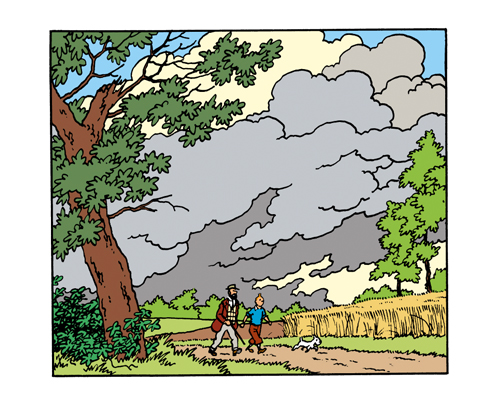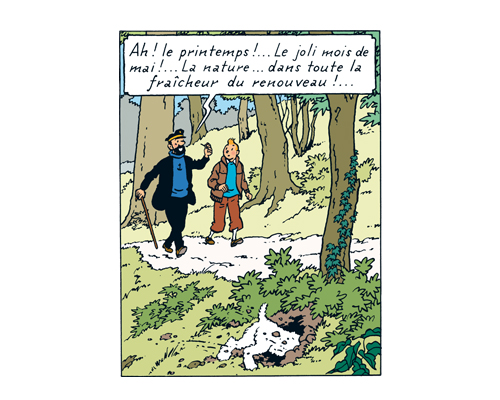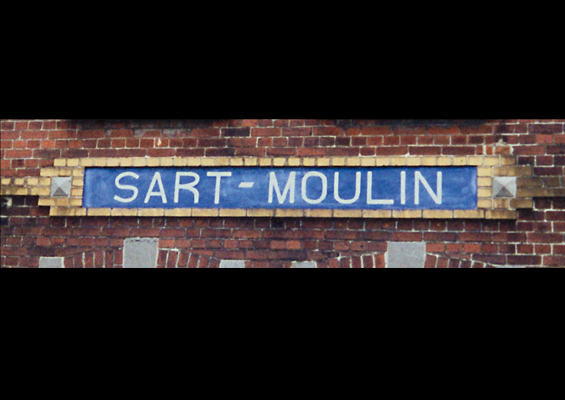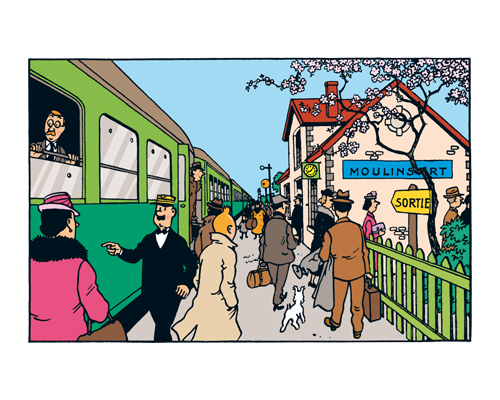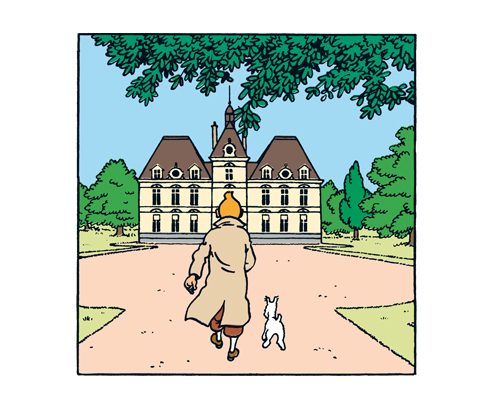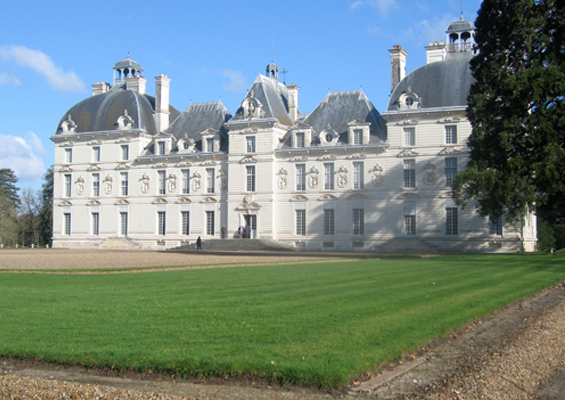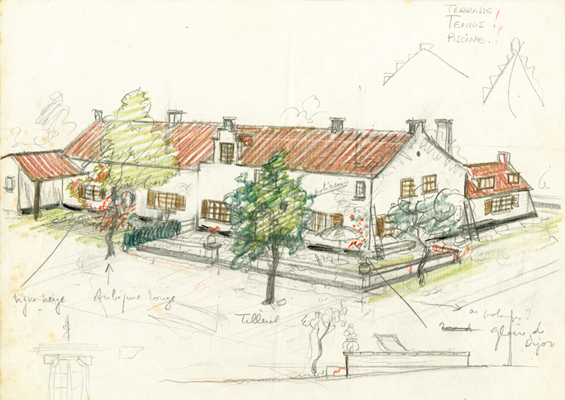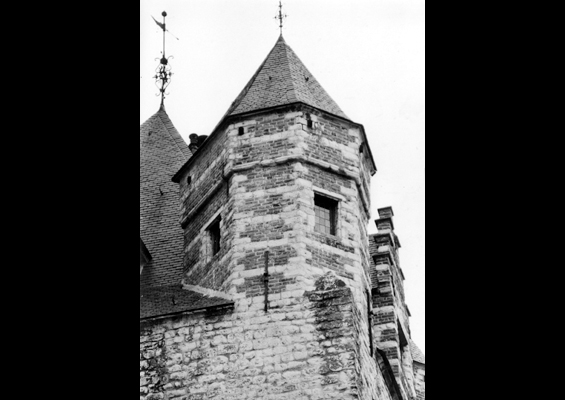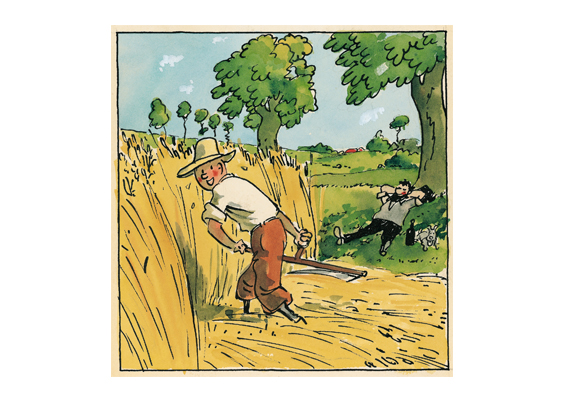Did Hergé live near Marlinspike hall ?

The new book by Dominique Maricq, 'Hergé côté jardin', follows Tintin and Hergé's footsteps around the countryside surrounding Marlinspike Hall, in reality the region of Walloon Brabant in Belgium, where Hergé lived for many years.
A book that takes you on a walk ?
'Hergé côté jardin' (Editions Moulinsart) takes the reader on a tour through the heart of the Walloon Brabant countryside, in the company of Hergé and Tintin. Could this be The Adventures of Tintin in Walloon Brabant? It would be more accurate to say Walloon Brabant in The Adventures of Tintin. Go through your Tintin books and you will come across the countryside evoked in Dominique Maricq's new book again and again in stories such as The Calculus Affair, The Castafiore Emerald and Tintin and the Picaros. The model behind Marlinspike Hall is French mansion the Château de Cheverny, but where does the name 'Moulinsart' (Marlinspike in French) come from? It's simple: all you have to do is reverse the syllables in the name of a hamlet situated in the Braine-l'Alleud region of Walloon Brabant: Sart-Moulin. And what about the rural countryside around Marlinspike Hall? There is no doubt that we are looking at Walloon Brabant, to be precise the undulating fields around Céroux-Mousty, Bousval and Limauges. Today many things are the same as they were when Hergé was alive: little roads here and there, small communities surrounding their churches, and crops of beetroot, like those surrounding Hergé's residence in the Rue de Ferrière. With Dominique Maricq's book in hand, take off on a tour of Walloon Brabant!
Walloon Brabant: A province of India
The great thing about Walloon Brabant is that it has conserved its character, and its residents maintain a certain quality of life. Today we can still identify the rustic environment that inspired Hergé as he wrote several of Tintin's stories. It is no accident that the Hergé Museum was built in the heart of this countryside, in the town of Louvain-la-Neuve. The world of Tintin is preserved between the gently sloping hills, undulating fields and picturesque woods. But something that you may not have known is that the countryside of Walloon Brabant even extends to India! On page 48 of Les Cigares du Pharaon (French version of Cigars of the Pharaoh), Tintin sets off in a train linking Arboujah to Sehru. At the beginning of the 1950s, when Hergé was redrawing this story, Nehru was the Prime Minister of India. Although there is only a difference of a single letter between 'Sehru' and 'Nehru', the latter is pronounced 'Nay-roo'. Hergé was again toying with words and sounds in his story: pronouncing the former word with the latter's pronunciation makes 'Céroux': the name of the village where Hergé lived.
Hergé, citizen of Walloon Brabant?
Although many people would answer 'no' to the question posed by this title, the answer is really 'yes'. It is assumed that since he was born in Brussels, and portrayed the city many times in his stories (including pages of Quick and Flupke as well as Tintin), Hergé must have been Bruxellois. In 'Hergé côté jardin', Dominique Maricq explains otherwise: Hergé acquired his house in Céroux-Mousty in 1949. It became his official residence in 1953, and he continued to visit the house and his estate until his death in 1983, 34 years later. Hergé clearly spent a large part of his life in this part of Belgium. Furthermore, Walloon Brabant as portrayed by Hergé in Tintin, remains relatively unchanged, at the outset of the twenty-first century. We couldn't say the same about Hergé's Brussels. Today, through his museum in Louvain-la-Neuve (opened in 2009), Hergé continues to attract new visitors to Walloon Brabant region, which he loved so dearly.
Marlinspike Hall: in France or Belgium?
This is a hot topic of debate among distinguished Tintinologists! In fact, the model of Marlinspike Hall is the Château de Cheverny in France. A brochure for the Château, including a number of photographs, can be found in Hergé's archives. Hergé was inspired by the building, as much by its architecture as by the décor inside. He removed the two wings of the Château to make Marlinspike Hall more manageable, and to allow it to fit better into his comic strip frames! As for the surroundings of Marlinspike, open 'Hergé côté jardin' to be convinced that they were inspired by the countryside of Walloon Brabant.
Dominique Maricq interviewed about the Walloon Brabant countryside and his book
Archivist and author at Studios Hergé, Dominique Maricq has carried out extensive research into the little-known life of Georges Remi at his countryside residence, located between Bousval and Céroux. Dominique has amassed a long list of anecdotes and interesting information.
Dominique Maricq : The love story between Hergé and Walloon Brabant, goes back a long way. From the 1930s, Hergé was seduced by the charm and calm of a region that he discovered while visiting the parents (who lived in Sart-Moulin) of his co-partner at the ephemeral Atelier Hergé, José De Launoit.
When did Hergé first discover the house, in Céroux-Mousty, that he would eventually buy?
D.M. : During WWII, the creator of Tintin, along with many other citizens, headed for the Walloon Brabant countryside to buy milk, butter, eggs and meat at a lower price than in Brussels. From Place Rouppe, in Brussels, he took the line W tram for Wavre (the capital of Walloon Brabant), on a journey through picturesque countryside. Like many other artists, Hergé looked for a calm environment in which he could be inspired. Just after the war - in the 1950s - Céroux-Mousty was a haven of peace. It was there that in 1949, he bought La Ferrière, an old country inn which he moved into in 1953.
In your book, you say that this calm was sometimes disturbed...
D.M. : At one point there was a neighbourly dispute between the comic-strip author and a YMCA youth club from Bousval, which established a base on land opposite the artist's garden. The anecdote has recently been told in an issue of Hergé magazine, published by Studios Hergé: 'The shouting, screaming and boisterous squawking of young children, was too much for Hergé and his neighbours. Repeated warnings seemed to have no effect, and appeals for calm didn't improve the situation. When they learned that the youth club had bought more land to enlarge its territory, Hergé and his neighbours went to court. It is an astonishing story: Hergé, ex-scout patrol leader and prodigious illustrator of a Belgian scout magazine, was forced into opposing the activities of another youth movement!'
But everything finished with singing and... drawing?
D.M. : In the end, the whole matter was ended amiably. Hergé bought the land from the youth club which, with the money, was able to establish itself further away in a wood where, three years later, they invited the artist for an afternoon event. The children and their supervisors were disguised as characters from The Adventures of Tintin. Today there remain a few photographs and a short film of the event, which I managed to acquire.
Tell us about the meticulous research you undertook, aided by the fact that you live in the area yourself.
D.M. : In 1997 I began a veritable police investigation, which resulted in the discovery of many unpublished documents and unexpected people. It is well known that in several adventures - The Castafiore Emerald and The Calculus Affair, for example - Hergé was directly inspired by the region of Walloon Brabant, as he drew his pictures. While Professor Auguste Piccard, who served as the model for Professor Cuthbert Calculus, never lived in the area, the spherical part of his first bathyscaphe was built in the Henricot metal plants in Court-Saint-Etienne. But Hergé was also inspired by people he met in the neighbourhood, as he created characters in his stories; my book sheds light on some of these people.
Could you give us a few examples?
D.M. : At the beginning of the 1950s, in Wavre, Hergé attended a series of conferences entitled l'Exploration du Monde. He met people like volcanologist Haroun Tazieff (who had grown up in the region) and Alain Bombard, the man who sailed across the Atlantic with no provisions, and who was later mentioned in The Red Sea Sharks. While visiting his friend Dr Brasseur-Capart's house (which still exists) on Bosch Square, Hergé would talk about the Doctor's father, Egyptologist Jean Capart, who inspired the character of Professor Tarragon from The Seven Crystal Balls. Hergé was not the only person to be impressed by Jean Capart's size and imposing beard: his colleague Edgar P. Jacobs was also inspired by Capart when he created Dr Grossgrabenstein from The Mystery of the Great Pyramid.
It seems that many comic strip authors were attracted to Walloon Brabant.
D.M. : It is true that the area, which is such a pleasure to live in, has become the golden triangle of Belgian comic strips. Jacques Martin (author of Alix, Lefranc, etc.) was one of Hergé's neighbours in Céroux. Martin continued to spend time in the area until his recent death. Of course the countryside is not quite the same as it was in the 1950s, but some places really haven't changed. In Royenne, Grez-Doiceau, there still exists a small farmhouse which once belonged to Carlo Speder, founder of the Péruchet puppet theatre; Hergé used the building in a couple of drawings. Moriensart Tower, in Céroux, is another one of these historical places that are still around. The visitors' book contains a wonderful illustration of the tower, signed by Hergé. It would be a good idea to write a tourist guide entitled Hergé in Walloon Brabant. But we would have to be careful with any signs that might go up to indicate the route: they would likely disappear as quickly as the plaque indicating the Rue Hergé in Céroux, which was lifted by a ruthless Tintin fan!




 News
News Forums
Forums E-books
E-books
